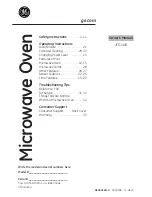
English - 25
06
COOKING TECHNIQUES
General tips
• Dense foods, such as potatoes, take longer to heat than lighter foods. Foods with a
delicate texture should be heated at a low power level to avoid becoming tough.
• Altitude and the type of cookware you are using can affect cooking time. When using
a new recipe, use the minimum cooking time and check the food occasionally to
prevent overcooking.
• Foods with a non-porous skin such as potatoes or hot dogs, should be pierced to
prevent bursting.
• Frying with heating oil or fat is not recommended. Fat and oil can suddenly boil over
and cause severe burns.
• Some ingredients heat faster than others. For example, the jelly inside a jelly
doughnut will be hotter than the dough. Keep this in mind to avoid burns.
• Home canning in the microwave oven is not recommended because all harmful
bacteria may not be destroyed by the microwave heating process.
• Although microwaves do not heat the cookware, the heat from the food is often
transferred to the cookware. Always use pot holders when removing food from the
microwave and instruct children to do the same.
• Making candy in the microwave is not recommended as candy can heat to very high
temperatures. Keep this in mind to avoid injury.
Auto sensor cook
The Auto Sensor allows you to cook your food automatically by detecting the amount of
moistures generated from the food while cooking.
• When cooking food, many kinds of moistures are generated. The Auto Sensor
determines the proper time and power level by detecting these moistures from the
food, eliminating the need to set the cooking time and power level.
• When you cover a container with its lid or plastic wrap during Sensor Cooking,
the Auto Sensor will detect the moistures generated after the container has been
saturated with steam.
• Shortly before cooking ends, the remaining cooking time will begin its count down.
This will be a good time for you to rotate or stir the food for even cooking if it is
necessary.
• Before auto sensor cooking food may be seasoned with herbs, spices or browning
sauces. A word of caution though, salt or sugar may cause burn spots on food so
these ingredients should be added after cooking.
Utensils & cover for sensor cooking
• To obtain good cooking results with this function, follow the directions for selecting
appropriate containers and covers in the charts in this book.
• Always use microwave-safe containers and cover them with their lids or with plastic
wrap. When using plastic wrap, turn back one corner to allow steam to escape at the
proper rate.
• Always cover with the lid intended for the utensil being used. If the utensil does not
have its own lid, use plastic wrap.
• Fill containers at least half full.
• Foods that require stirring or rotating should be stirred or turned toward the end of
the Sensor Cook cycle, after the time has started to count down on the display.
Important
• It is not advisable to use the auto sensor cooking feature on a continuous cooking
operation, i.e. one cooking operation immediately after another.
• Install the oven in a well ventilated location for proper cooling and airflow and to
ensure the sensor will operate accurately.
• To avoid poor results, do not use the Auto sensor when the room ambient
temperature is too high or too low.
• Do not use volatile detergent to clean your oven. Moisture resulting from this
detergent may affect the sensor.
• Avoid placing the oven near high moisture or gas emitting appliances, since this will
interfere with the proper performance of the Auto Sensor.
• Always keep the inside of the oven clean. Wipe all spills with a damp cloth.
• This oven is designed for household use only.
ME6104W1_XSA_DE68-04262B-01_EN.indd 25
2014-08-18 4:54:27








































